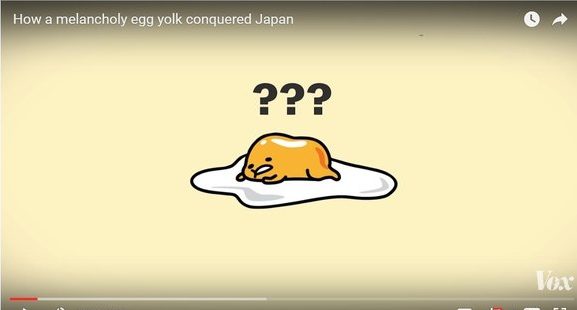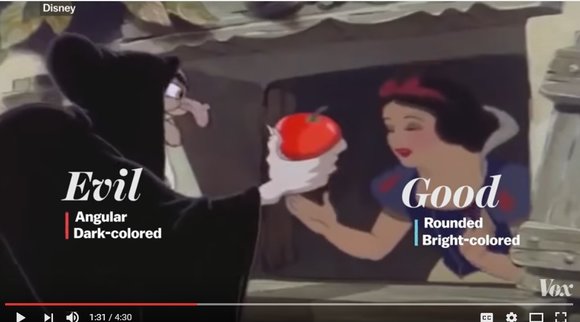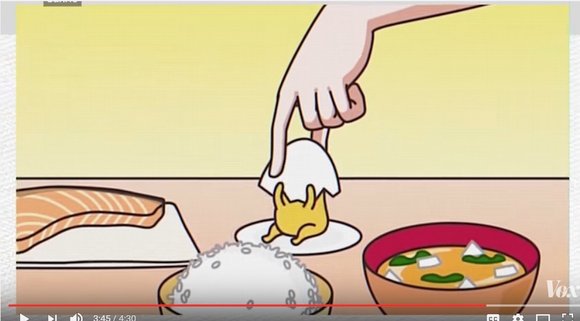
The team at Vox shed light onto the development and popularity of the lovable egg with a bum.
Sanrio is best-known as the company that’s been producing Hello Kitty merchandise since 1974 (along with merch for newer characters like Aggretsuko the office-worker red panda). One of Sanro’s most popular characters these days is Gudetama, a melancholy egg yolk.
In a recent video, Dion Lee and Alex Abad-Santos of Vox explain what Gudetama is, how it was developed, and possible reasons the eggy icon has become such a phenomenal hit.
Despite only coming in second place in a 2013 company-wide competition to find a new food-based character (rather bizarrely losing out to a salmon fillet, who’s now a star in her own right), Gudetama has gone on to become one of their most successful characters. But why do people relate to an amorphous sloth-like egg? To explain, Vox go on to try and explain the cultural differences between Western and Japanese definitions of “cuteness” by using Disney characters as a comparison. Although in doing this, I think they overegg the differences a bit much.
They then go on to explain the causes of Japan’s affinity for “kawaii” culture by linking it to an acceptance by Japan of the Potsdam Declaration at the end of World War II, and the sense of vulnerability that this engendered.
In recent years, Sanrio’s characters have evolved from the mouth-less “blank canvas” characters onto whom you can project your own feelings, like Hello Kitty, to characters with personalities we can relate to like Aggretsuko or Gudetama. In our stressful, modern existence the guys at Vox posit the question that maybe all we need is an “egg yolk with a little bum, who’s given up on life”.
While its form may be sunny-side up, Gudetama’s disposition is rather less so, but maybe Gudetama appeals because we’ve all had days when we wanted to take cover under a protective shell.
Source, images: YouTube/Vox




 Meet the most unmotivated Sanrio character ever — Gudetama, the lazy egg!
Meet the most unmotivated Sanrio character ever — Gudetama, the lazy egg! Sanrio’s lazy egg character appears on menu items at new Gudetama Cafe in Osaka
Sanrio’s lazy egg character appears on menu items at new Gudetama Cafe in Osaka Sanrio’s Gudetama is getting a Netflix series…that’s live-action??
Sanrio’s Gudetama is getting a Netflix series…that’s live-action?? Gudetama the lazy egg shines — as stylish gold and platinum jewelry!
Gudetama the lazy egg shines — as stylish gold and platinum jewelry! Lazy Sanrio egg Gudetama opens new restaurant in Tokyo!
Lazy Sanrio egg Gudetama opens new restaurant in Tokyo! Private booths are coming to Japan’s Shinkansen bullet trains even sooner than we’d thought【Video】
Private booths are coming to Japan’s Shinkansen bullet trains even sooner than we’d thought【Video】 Rakuten randomly offers 58 New Year’s osechi feasts in Japan, but did we get a star or a dud?
Rakuten randomly offers 58 New Year’s osechi feasts in Japan, but did we get a star or a dud? Top Japanese cosplayer Enako returns to Comiket after 6 years, creates mayhem with admirers
Top Japanese cosplayer Enako returns to Comiket after 6 years, creates mayhem with admirers Japanese beef bowl chain Sukiya’s 2026 Smile Box lucky bag basically pays for itself
Japanese beef bowl chain Sukiya’s 2026 Smile Box lucky bag basically pays for itself Majority of Japanese mayors say foreign residents are essential but most see good and bad effects
Majority of Japanese mayors say foreign residents are essential but most see good and bad effects Real Buddhist monk plays Super Mario Bros., recites prayers every time he kills an enemy【Video】
Real Buddhist monk plays Super Mario Bros., recites prayers every time he kills an enemy【Video】 Japan’s new frozen sushi DIY kit – Great foodie fun, or cold-hearted abomination?【Taste test】
Japan’s new frozen sushi DIY kit – Great foodie fun, or cold-hearted abomination?【Taste test】 Cosplay costume room tour by Japan’s number-one cosplayer Enako is an eye-opener【Video】
Cosplay costume room tour by Japan’s number-one cosplayer Enako is an eye-opener【Video】 The Purple Lucky Bag from Village Vanguard is an extra-large waste of money
The Purple Lucky Bag from Village Vanguard is an extra-large waste of money Starbucks Japan ready to get Year of the Horse started with adorable drinkware and plushies【Pics】
Starbucks Japan ready to get Year of the Horse started with adorable drinkware and plushies【Pics】 Hayao Miyazaki says Happy New Year to Studio Ghibli fans with new art for Year of the Horse
Hayao Miyazaki says Happy New Year to Studio Ghibli fans with new art for Year of the Horse Cup Noodle tries an authentic Jiro-style ramen, but something’s not quite right
Cup Noodle tries an authentic Jiro-style ramen, but something’s not quite right The best Starbucks Japan Frappuccinos we want to drink again in 2026
The best Starbucks Japan Frappuccinos we want to drink again in 2026 We revisited Sweets Paradise after a decade to see if Japan’s dessert buffet still delivers
We revisited Sweets Paradise after a decade to see if Japan’s dessert buffet still delivers That time Seiji called JASRAC to ask why he didn’t get paid royalties for his song being on TV
That time Seiji called JASRAC to ask why he didn’t get paid royalties for his song being on TV We found possibly the quietest Japanese-style hotel in Tokyo’s bustling Shinjuku district
We found possibly the quietest Japanese-style hotel in Tokyo’s bustling Shinjuku district Pizza Hut Japan’s hot lucky bags are perfect for a New Year’s pizza party
Pizza Hut Japan’s hot lucky bags are perfect for a New Year’s pizza party Japan’s oldest largetooth sawfish in captivity back on display in Mie Prefecture
Japan’s oldest largetooth sawfish in captivity back on display in Mie Prefecture 7-Eleven Japan starts new temporary luggage storage service in over 300 branches
7-Eleven Japan starts new temporary luggage storage service in over 300 branches Disillusionment at Tsukiji’s tourist-target prices led us to a great ramen restaurant in Tokyo
Disillusionment at Tsukiji’s tourist-target prices led us to a great ramen restaurant in Tokyo Starbucks teams up with 166-year-old Kyoto doll maker for Year of the Horse decorations【Photos】
Starbucks teams up with 166-year-old Kyoto doll maker for Year of the Horse decorations【Photos】 Tokyo considering law requiring more trash cans following litter increase in heavily touristed area
Tokyo considering law requiring more trash cans following litter increase in heavily touristed area Tokyo’s Tsukiji sushi neighborhood asks tour groups to stay away for the rest of the month
Tokyo’s Tsukiji sushi neighborhood asks tour groups to stay away for the rest of the month Tokyo event lets you travel back in time, for free, to celebrate 100 years since Showa era start
Tokyo event lets you travel back in time, for free, to celebrate 100 years since Showa era start Japan may add Japanese language proficiency, lifestyle classes to permanent foreign resident requirements
Japan may add Japanese language proficiency, lifestyle classes to permanent foreign resident requirements Sanrio theme park in Japan announces plans to expand into a Sanrio resort
Sanrio theme park in Japan announces plans to expand into a Sanrio resort Stamina-destroying “Paralysis Noodles” are Tokyo’s newest over-the-top ramen innovation
Stamina-destroying “Paralysis Noodles” are Tokyo’s newest over-the-top ramen innovation Survey asks foreign tourists what bothered them in Japan, more than half gave same answer
Survey asks foreign tourists what bothered them in Japan, more than half gave same answer Japan’s human washing machines will go on sale to general public, demos to be held in Tokyo
Japan’s human washing machines will go on sale to general public, demos to be held in Tokyo Japan’s deadliest food claims more victims, but why do people keep eating it for New Year’s?
Japan’s deadliest food claims more victims, but why do people keep eating it for New Year’s? We deeply regret going into this tunnel on our walk in the mountains of Japan
We deeply regret going into this tunnel on our walk in the mountains of Japan Studio Ghibli releases Kodama forest spirits from Princess Mononoke to light up your home
Studio Ghibli releases Kodama forest spirits from Princess Mononoke to light up your home Major Japanese hotel chain says reservations via overseas booking sites may not be valid
Major Japanese hotel chain says reservations via overseas booking sites may not be valid Put sesame oil in your coffee? Japanese maker says it’s the best way to start your day【Taste test】
Put sesame oil in your coffee? Japanese maker says it’s the best way to start your day【Taste test】 No more using real katana for tourism activities, Japan’s National Police Agency says
No more using real katana for tourism activities, Japan’s National Police Agency says Starbucks Japan reveals new sakura drinkware collection, inspired by evening cherry blossoms
Starbucks Japan reveals new sakura drinkware collection, inspired by evening cherry blossoms Updated cherry blossom forecast shows extra-long sakura season for Japan this year
Updated cherry blossom forecast shows extra-long sakura season for Japan this year Eat these new desserts and celebrate the weirdest Easter ever with the lazy egg Gudetama
Eat these new desserts and celebrate the weirdest Easter ever with the lazy egg Gudetama Gudetama the lazy egg comes to Kyoto—as Japanese-style cafe treats!
Gudetama the lazy egg comes to Kyoto—as Japanese-style cafe treats! Video of lazy egg Gudetama cleaning up goes viral on Twitter【Video】
Video of lazy egg Gudetama cleaning up goes viral on Twitter【Video】 Sanrio’s Gudetama 1st anime short streamed
Sanrio’s Gudetama 1st anime short streamed Gudetama the lazy egg now being served as actual dish, looks absolutely adorable!
Gudetama the lazy egg now being served as actual dish, looks absolutely adorable! Sanrio terror — Horrifying “real-world Gudetama” appears in Japanese kitchen
Sanrio terror — Horrifying “real-world Gudetama” appears in Japanese kitchen Gudetama the lazy egg is adorable … even as he poops and vomits! 【Video】
Gudetama the lazy egg is adorable … even as he poops and vomits! 【Video】 Sanrio releases new character: Aggretsuko, the white-collar red panda with anger issues
Sanrio releases new character: Aggretsuko, the white-collar red panda with anger issues Sanrio characters Gudetama and Pom Pom Purin are now sweeter than ever as donuts 【Photos】
Sanrio characters Gudetama and Pom Pom Purin are now sweeter than ever as donuts 【Photos】 Tokyo spas offer limited-time Gudetama and Kero Kero Keroppi baths and goodies【Photos】
Tokyo spas offer limited-time Gudetama and Kero Kero Keroppi baths and goodies【Photos】 Godzilla and Gudetama is the cutest collaboration between a terrifying monster and lazy egg ever!
Godzilla and Gudetama is the cutest collaboration between a terrifying monster and lazy egg ever! Sanrio’s laziest character gets a hand from its surliest as Bad Badtz-Maru joins Gudetama Cafe
Sanrio’s laziest character gets a hand from its surliest as Bad Badtz-Maru joins Gudetama Cafe Japanese sento bath will let you bathe with 10,000 Sanrio Gudetamas【Video】
Japanese sento bath will let you bathe with 10,000 Sanrio Gudetamas【Video】 We love Gudetama so much, we turn him into adorable okonomiyaki pancakes and eat him!
We love Gudetama so much, we turn him into adorable okonomiyaki pancakes and eat him! Now you can eat Gudetama’s mom as Sanrio cafe unveils darkest dish yet for new Tokyo restaurant
Now you can eat Gudetama’s mom as Sanrio cafe unveils darkest dish yet for new Tokyo restaurant Time to vote for your favourite in Japan’s Sanrio Character Curry Election
Time to vote for your favourite in Japan’s Sanrio Character Curry Election
Leave a Reply